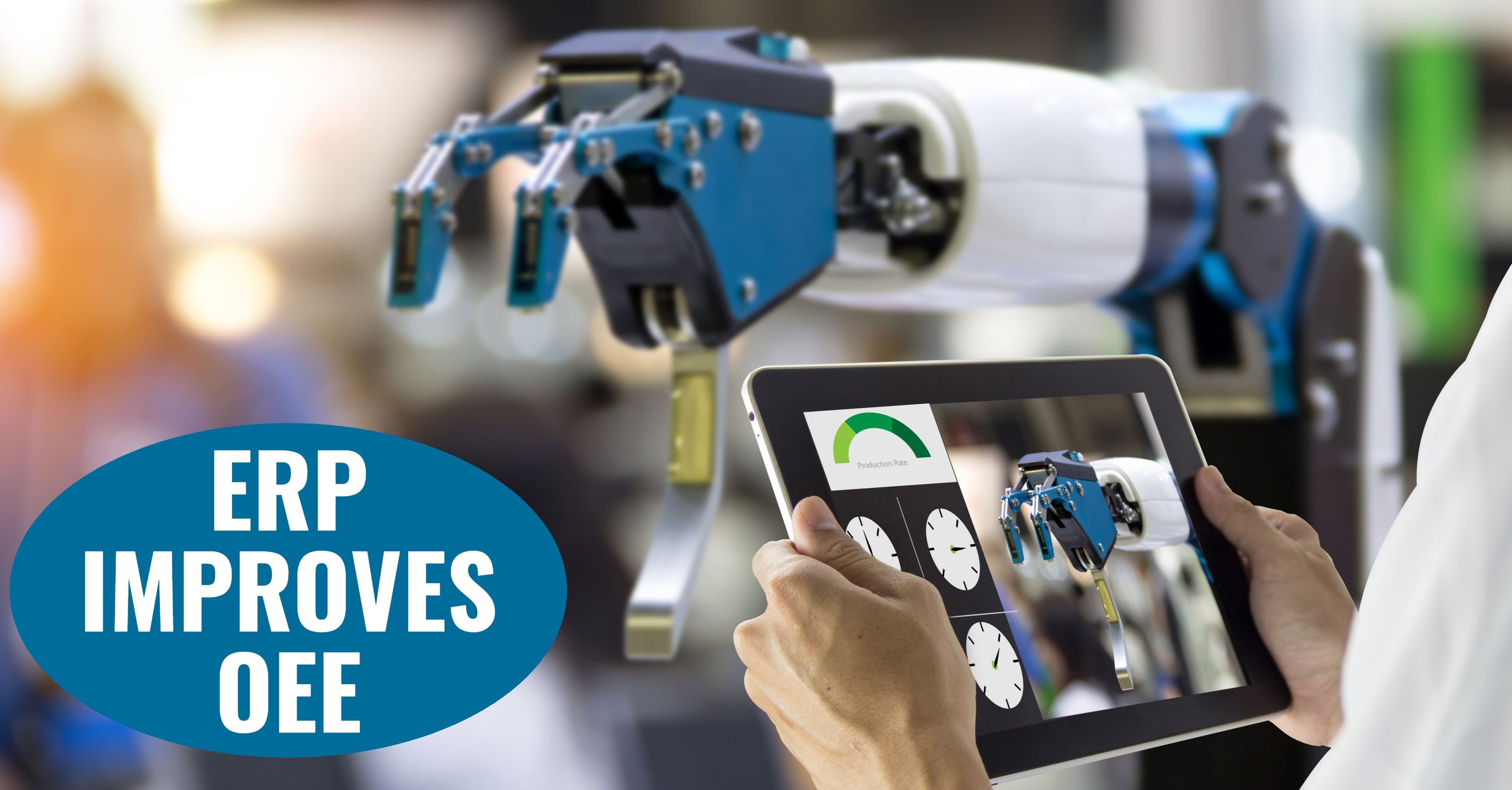Increase Overall Equipment Effectiveness
Overall equipment effectiveness (OEE) is regarded as one of the most critical metrics for measuring manufacturing productivity. A high OEE score means you’re creating quality parts as fast as possible with minimal stop times. Though manufacturers typically aim for at least 85% OEE, many stray well behind this goal, stuck in the 40-60% range.
Some manufacturers struggle to calculate OEE at all. Legacy software doesn’t have the sophistication to collect accurate data from your assets, machines and product lines. Manually assembling this information takes time away from other essential tasks and is susceptible to human error.
The only reliable method of calculating OEE is through utilizing enterprise resource planning (ERP) software. ERP serves as a central hub for enterprise data from the top floor to the shop floor. As ERP vendors add more cutting-edge tools to their solutions, manufacturers not only gain a more accurate picture of OEE but also discover new methods to optimize productivity. Below, we describe the ERP features and capabilities that can help you improve OEE.
Manufacturing Execution System
To elevate operations, manufacturers need an ERP solution that includes a manufacturing execution system (MES). By automatically monitoring and analyzing production data at all hours of the day, MES is able to provide real-time insights and precisely calculate OEE. Accurate OEE, scrap rates, material consumption and other metrics are delivered instantly to enable users to reduce waste, improve quality and locate issues.
Epicor Advanced MES (Mattec) can be tightly integrated with your Epicor ERP solution to provide in-depth insights into your production performance. Touch screen technology allows shop floor operators to easily view real-time data from your equipment without manual data entries. They immediately receive notifications of shop warnings, scrap and process variations, so they can schedule preventative maintenance before experiencing unplanned downtime. Analytics and drill-down capabilities also reveal the root causes of waste, delays and other costly problems. With reliable manufacturing data at your fingertips, you can strategically optimize production processes and avoid critical errors.
Internet of Things
The Internet of Things (IoT) is another valuable component for improving OEE. Using IoT technology, users gain automatic data from their equipment and assets. Metrics generated from sensors give you a wealth of insights, such as abnormal workplace conditions or slow machine performance. Real-time data optimizes preventative maintenance and quality management to increase OEE along with customer satisfaction. With granular insights in the palm of your hand, you can fix anything along your production line, from minor inefficiencies in product changeovers to equipment failure.
The latest version of Epicor 10 brings IoT and ERP together to streamline performance and consolidate manufacturing data. The user-friendly IoT dashboard provides an overview of real-time metrics on all assets and instantly notifies users of problems. Once you’ve been notified, you can quickly create a DMR or rework order to be sent off through your ERP system to avoid production roadblocks. Epicor also updated its MES shop floor interface, adding IoT technology to deliver automatic alerts of equipment status and health. With your ERP, MES and IoT working as one, you can combat waste and downtime to maximize your manufacturing productivity.
Interconnected Modules
MES and IoT aren’t the only tools that should be interconnected in your ERP solution. Maximizing efficiency and increasing OEE rates require total alignment of your manufacturing operations. ERP brings together several modules and features to deliver a unified vision of your manufacturing availability, performance and quality, so you can identify the root causes of issues and make strategic improvements.
Epicor is a comprehensive ERP solution that powers end-to-end visibility. With an interconnected ERP platform, you can leverage the following capabilities to optimize OEE:
- Elevate product quality by refining warehousing, procurement, receiving and other processes.
- Utilize planning, forecasting and inventory management tools to meet customer demand.
- Improve the efficiency of your entire production process by managing raw materials, WIP and finished goods as well as tracking order shipments.
- Align OEE strategies with other organizational goals, such as decreasing costs and increasing capacity.
- Evaluate how OEE performance impacts cost and revenue.
- Compare OEE metrics with other measurements such as scrap rates, cost of quality and overall labor effectiveness (OLE) to detect issues and enhance operations.
Wrap Up
With OEE serving as one of the most vital metrics in manufacturing, you can’t rely on disjointed applications or manual calculations. Epicor ERP offers real-time data and advanced analytics, so you always know how your enterprise is performing. This level of insight is critical for increasing OEE and making other improvements from top to bottom.
For over 20 years, Datix has specialized in delivering software solutions and services for manufacturers and distributors. We’re an Epicor Gold Partner with a reputation for working with clients from start to finish to maximize the value of their ERP. Our certified consultants understand manufacturing priorities and how to achieve business goals through software.
Become a more productive and profitable manufacturer. Contact Datix today to learn more about Epicor ERP!
{{cta(‘770c1544-d87d-4acb-9fc4-7a25e1385094′,’justifycenter’)}}


